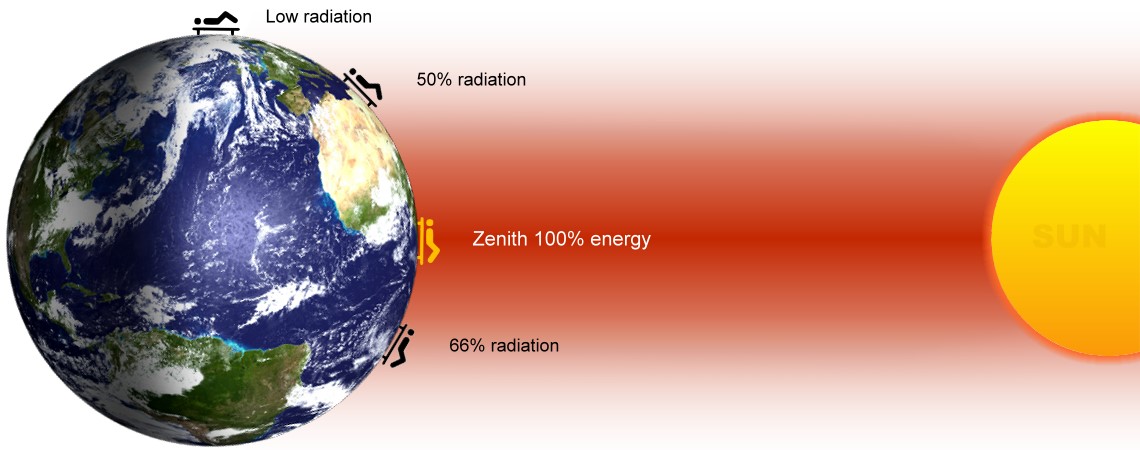How to determine the most suitable sun exposure?
Several ways to see things according to your ability to resist the sun on a beach. Of course, we are not all equal under the sun and all countries are not equal either when the intensity of the sun, normalized by UV index. The solar power (infrared and ultraviolet rays) affects you according to several factors: the unusual ray of the beach, the month of the year, the cloud cover, your lying or standing position and finally the time of exposure.
For those who do not know the beach in the tropics, it should be noted that the sun is much more powerful than the beaches around the Hamptons (New York State) in summer. Indeed, over 40 ° around the equator, the intertropical zone imposes not only, a constant thermal mass all year, more or less wet, but also the highest UV index. It is often said that in these latitudes, the sun stings the skin, and the locals protect themselves as much as possible.

Which countries are most exposed to the sun?
In descending order, but with little difference, here are the most difficult countries to expose yourself to the sun. The sun stings the skin, causes burns to fragile people in case of too long exposures. These destinations welcome tourists seeking sun and beaches. They are located between the two tropics, precisely between latitudes +23° and -23° and are subjected annually to the strongest solar rays on Earth. It is therefore imperative to be careful about tanning and sun exposure around noon when the sun is at its zenith:
Canary islands at Fuerteventura, Guyana at Georgetown, Seychelles islands at Praslin, Kenya at Mombasa, Maldives at Male, Seychelles islands at La Digue, Brazil at Fortaleza, Brazil at Belem, Brazil at Recife, Tanzania at Zanzibar, Sri lanka at Colombo, Thailand at Phuket, Malaysia at Langkawi, French guyana at Cayenne, Salomon islands at Honiara, Indonesia at Jakarta, Panama at Panama, Thailand at Koh Samui, Indonesia at Medan, Costa rica at Puerto Limon, Tuvalu at Fongafale, Philippines at Cebu, Papua new guinea at Port Moresby, Venezuela at Maracaibo, Curacao at Willemstad, Trinitad and tobago at Tobago, Venezuela at Caracas, Vietnam at Nha Trang, Cambodia at Sihanoukville, Mayotte at Dzaoudzi, Barbados at Bridgetown, St vincent grenadines at Kingstown, Comoros at Moroni, Madagascar at Tananarive, Colombia at San Andres, Aruba at Oranjestad.
In descending order, here are the easiest countries to expose yourself to the sun. The sun does not sting the skin but causes burns to people extremely fragile in case of prolonged exposure. These countries also welcome tourists seeking sun and beaches. They are located far from the tropics: Turkey at Izmir, Greece at Athens, Sicily at Palermo, Spain at Ibiza, Portugal at The Azores, Portugal at Lisbon, Spain at Bernidorm, Spain at Majorca, Sardinia at Cagliari, Italy at Naples, Italy at Brindisi, Portugal at Porto, Corsica at Ajaccio, Croatia at Dubrovnik, France at Marseille, France at Saint Tropez, France at Lacanau.
How are these results calculated?
The sun at its zenith, that is, around noon and well perpendicular to the surface of the Earth, sends 100% of radiation and heat. Depending on the latitude of your beach (distance in degrees from the equator at 0), plus the Earth celestial inclination of 23°, trigonometry gives us two optimal values ??in January and July, in winter and summer (inverted according to the northern or southern hemisphere). Both values ??are added to give an average. Thus, the results show that the beaches where it hits the most are just south of the equator. You will find these calculated values ??in each page of the range destinations in this format:



You observe that the percentage of radiation is different in summer and winter except for countries close to the equator. The higher the two ratios, the more you are in the tropical zone. It is hot all year round, sometimes humid and the sea temperature is high and fairly constant. Below 75%, the freshness can even be felt some months or at night and the sea temperature can be cold.
